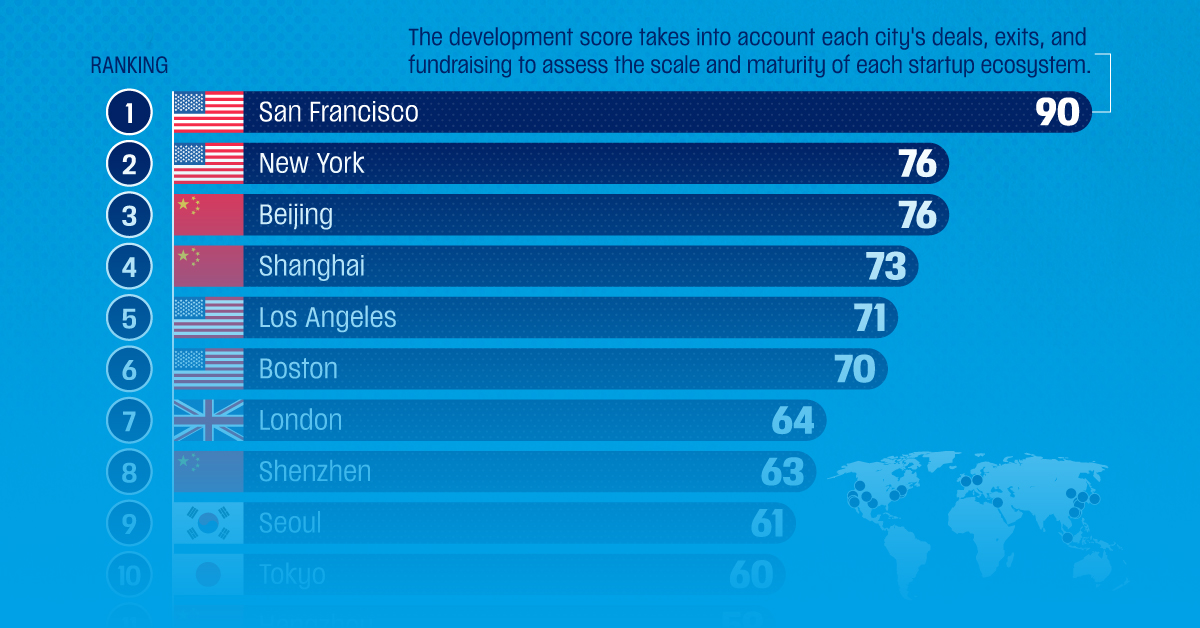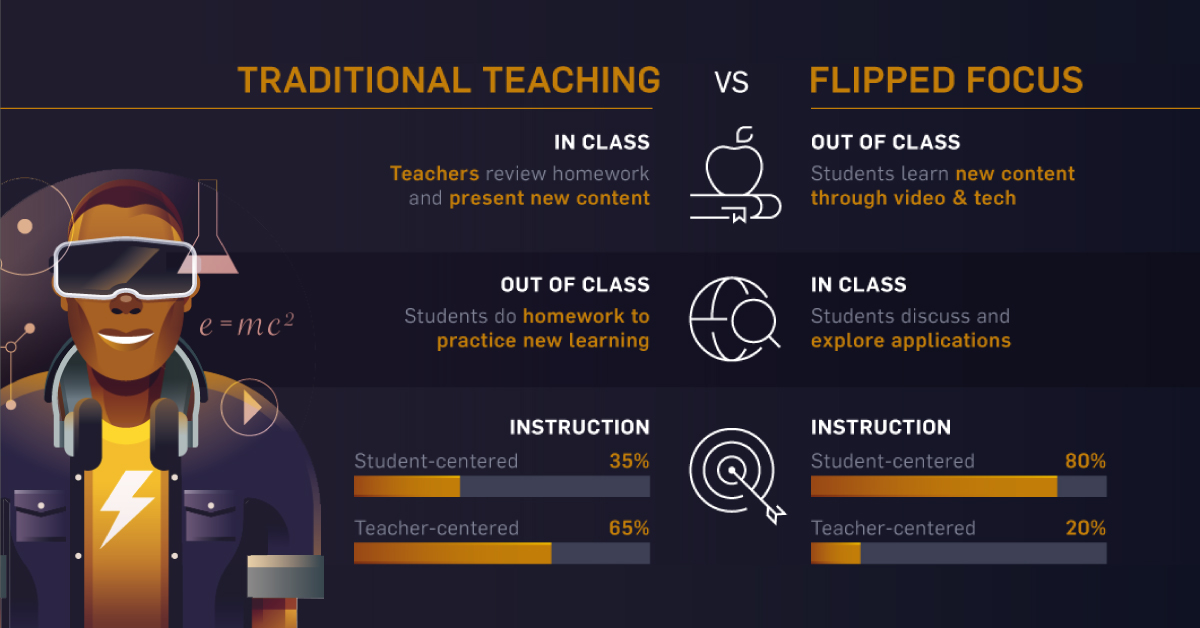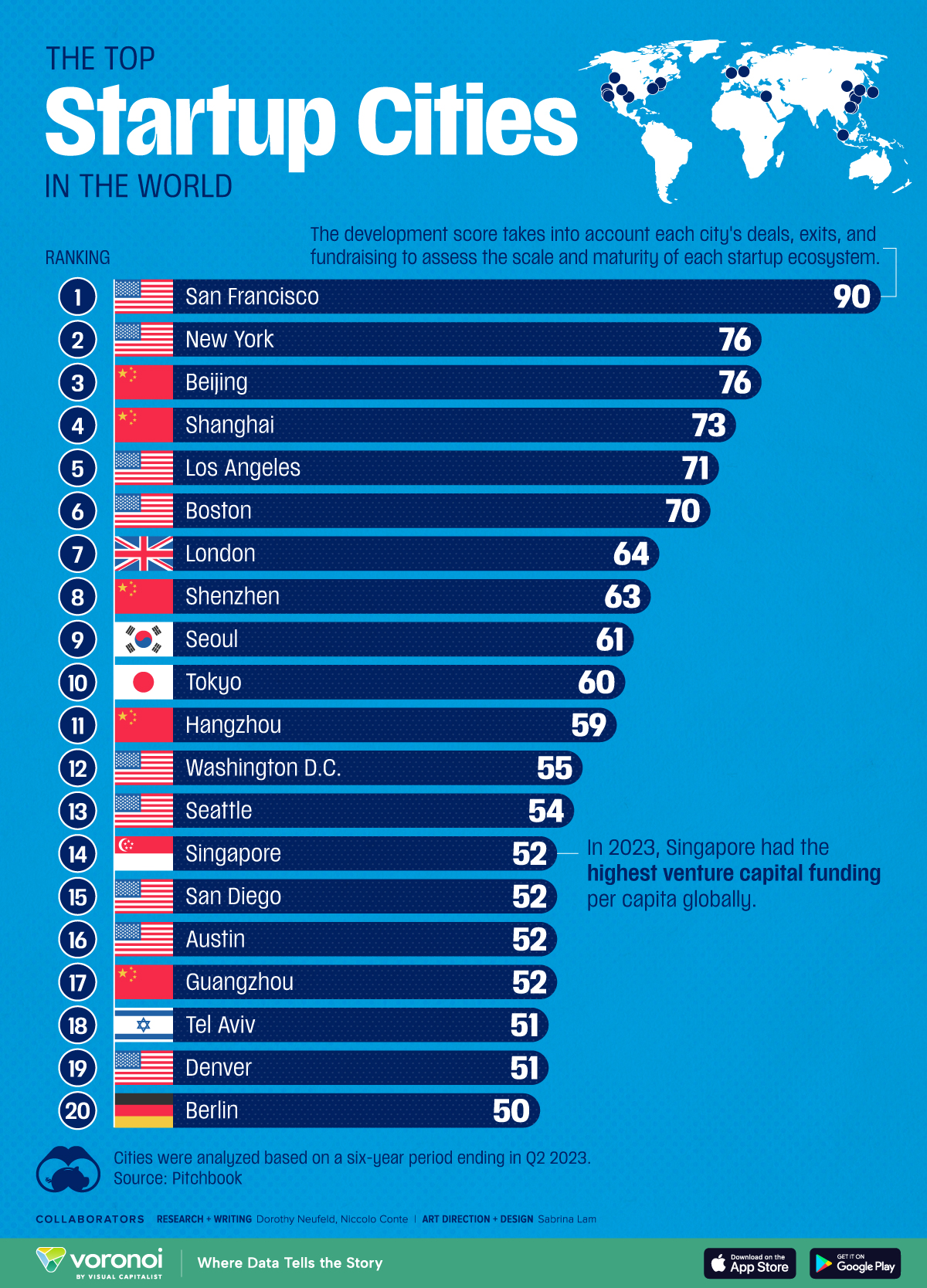Technology
How Technology is Shaping the Future of Education
Technology has transformed almost every aspect of our lives, and now it seems that education systems around the world are due for an update.
Educators are tapping into the digital revolution and adopting new technologies to help students reach their full potential, but can they adapt quickly enough to prepare children for the changing future of work?
The Growing Role of Tech in Classrooms
Today’s infographic from Best Education Degrees explores the different ways technology is transforming classrooms, and disrupting education as we know it.

The Next Generation
Although some might view technology as pervasive, for younger generations, it is ever-present.
Children and young adults make up one-third of all internet users, so it’s no surprise that they are more hyper-connected and digitally savvy than their parents.
The combination of evolving educational needs for children and a more uncertain future of work means that updating what children learn, and how they learn it, has become a crucial issue for schools and colleges—but what should be prioritized?
Classrooms 2.0
In a survey of 1,400 educators, the majority of them say they believe that classrooms of the future will be centered around self-paced and personalized learning.
This student-centric approach would allow children to choose their own pace and learning objectives based on individual interests—all of which could be guided by artificial intelligence, chatbots, and video-based learning.
Artificial Intelligence
Artificial intelligence in education typically focuses on identifying what a student does or doesn’t know, and then subsequently developing a personalized curricula for each student.
The AI-powered language learning platform Duolingo is one of the most downloaded education apps globally, with more than 50 million installs in 2018. The platform single-handedly challenges the notion of traditional learning, with a study showing that spending just 34 hours on the app equates to an entire university semester of language education.
AI-driven applications in education are still in their infancy, but Duolingo’s success demonstrates the growth potential in the sector. In fact, the nascent market for AI in education is expected to reach $6 billion by the year 2025. Over half of this will come from China and the U.S., with China leading globally.
Chatbots
Chatbots are also quickly becoming a fundamental tool in next generation education. Designed to simplify the interaction between student and computer, chatbots provide a wide range of benefits, including:
- Spaced interval learning: Uses algorithms and repetition to optimize memorization
- Immediate feedback: Papers can be graded with 92% accuracy and in a faster time than teachers
- Self-paced learning: Tracks a student’s performance and guides them based on their individual needs
This innovative technology is arming educators with new strategies for more engaged learning, whilst simultaneously reducing their workload.
Video Learning
Although video-based learning may not necessarily be considered as innovative as artificial intelligence or chatbots, 98% of educators view it as a vital component in personalized learning experiences. Most institutions report incorporating video into their curriculums in some way, but even higher demand for video-based learning may come from students in the near future.
This is due to the fact that video learning increases student satisfaction by 91%, and student achievements by 82%, which could be why educators are increasingly using video for tasks like:
- Providing material for student assignments
- Giving feedback on assignments
- Flipped instruction (blended learning) exercises
A flipped classroom overturns conventional learning by focusing on practical content that is delivered online and often outside the classroom.
The Battle Between Traditional and Tech
Flipping classrooms is a trend that has gained momentum in recent years—and may be considered to be a radical change in how students absorb information. The relatively new model also eliminates homework, by empowering students to work collaboratively on their tasks during class time.
Although new models of learning are disrupting the status quo of traditional learning, could the increasing amount of time children spend in front of screens be detrimental?
Research has shown that children are more likely to absorb information from books rather than screens. There has also been an evident increase in low-tech or tech-free schools that believe that human interaction is paramount when it comes to keeping children engaged and excited to learn.
Creating First-Class Humans
Although we may not be in the era of iTeachers just yet, the benefits of technology as teaching aids are undeniable. However, what is more important is that these aids are used in tandem with developmental and educational psychology—ultimately keeping students rather than technology at the core of education.
The future will be about pairing the artificial intelligence of computers with the cognitive, social and emotional capabilities of humans, so that we educate first-class humans, not second-class robots”
—OECD, Trends Shaping Education report
After all, how children develop these skills is perhaps less important than their ability to navigate change, as that is the only thing that will remain constant.
Technology
Ranked: The Top Startup Cities Around the World
Here are the global startup ecosystem rankings, highlighting the scale and maturity of major tech hubs worldwide.

The Top Startup Cities Around the World
This was originally posted on our Voronoi app. Download the app for free on iOS or Android and discover incredible data-driven charts from a variety of trusted sources.
A richly connected network of founders, venture capital firms, and tech talent are some of the key ingredients driving a startup ecosystem.
As engines of growth, these tech clusters are evolving on a global scale. While the world’s leading startup cities are concentrated in America, several ecosystems, such as Beijing and Seoul, are growing in prominence as countries focus on technological advancement to spur innovation.
This graphic shows the best startup cities worldwide, based on data from Pitchbook.
The Global Startup Ecosystem Rankings
To determine the rankings, each city was analyzed based on the scale and maturity of their startup ecosystem over a six-year period ending in the second quarter of 2023.
Among the inputs analyzed and used to calculate the overall development score were fundraising activity, venture capital deals, and exit value:
| Rank | City | Development Score | Capital Raised | Deal Count | Exit Value |
|---|---|---|---|---|---|
| 1 | 🇺🇸 San Francisco | 90 | $427.6B | 19,898 | $766.3B |
| 2 | 🇺🇸 New York | 76 | $179.9B | 13,594 | $171.7B |
| 3 | 🇨🇳 Beijing | 76 | $161.2B | 8,835 | $279.2B |
| 4 | 🇨🇳 Shanghai | 73 | $130.3B | 7,422 | $186.8B |
| 5 | 🇺🇸 Los Angeles | 71 | $144.6B | 9,781 | $181.4B |
| 6 | 🇺🇸 Boston | 70 | $117.0B | 6,044 | $172.8B |
| 7 | 🇬🇧 London | 64 | $99.0B | 11,533 | $71.9B |
| 8 | 🇨🇳 Shenzhen | 63 | $46.4B | 5,020 | $66.3B |
| 9 | 🇰🇷 Seoul | 61 | $31.1B | 6,196 | $71.0B |
| 10 | 🇯🇵 Tokyo | 60 | $26.2B | 5,590 | $28.0B |
| 11 | 🇨🇳 Hangzhou | 59 | $50.7B | 3,361 | $88.7B |
| 12 | 🇺🇸 Washington D.C. | 55 | $43.7B | 2,706 | $28.2B |
| 13 | 🇺🇸 Seattle | 54 | $31.7B | 2,693 | $35.6B |
| 14 | 🇸🇬 Singapore | 52 | $45.7B | 4,507 | $38.0B |
| 15 | 🇺🇸 San Diego | 52 | $33.5B | 2,023 | $44.7B |
| 16 | 🇺🇸 Austin | 52 | $26.4B | 2,636 | $22.9B |
| 17 | 🇨🇳 Guangzhou | 52 | $24.7B | 1,700 | $24.0B |
| 18 | 🇮🇱 Tel Aviv | 51 | $21.0B | 1,936 | $32.2B |
| 19 | 🇺🇸 Denver | 51 | $26.8B | 2,489 | $29.9B |
| 20 | 🇩🇪 Berlin | 50 | $31.2B | 2,469 | $15.9B |
San Francisco dominates the pack, with $427.6 billion in capital raised over the six-year period.
Despite a challenging funding environment, nearly 20,000 deals closed, highlighting its outsized role in launching tech startups. Both OpenAI and rival Anthropic are headquartered in the city, thanks to its broad pool of tech talent and venture capital firms. Overall, 11,812 startups were based in the San Francisco Bay Area in 2023, equal to about 20% of startups in America.
Falling next in line is New York City, which raised $179.9 billion over the same time period. Crypto firm Gemini and machine learning company, Hugging Face, are two examples of startups based in the city.
As the top-ranking hub outside of America, Beijing is home to TikTok’s parent company, ByteDance, which is one of the most valuable private companies in the world.
In recent years, much of the startup funding in China is being driven by government-backed funds. In particular, these funds are focusing heavily on “hard tech” such as semiconductor-makers and electric vehicle companies that align with the government’s strategic long-term goals.
Another leading tech hub, Singapore, has the highest venture capital funding per capita worldwide. In 2023, this was equal to an impressive $1,060 in venture funding per person. By comparison, venture funding was $345 per person in the U.S., the second-highest globally.
-

 Healthcare2 weeks ago
Healthcare2 weeks agoWhich Countries Have the Highest Infant Mortality Rates?
-

 Misc1 week ago
Misc1 week agoVisualizing Global Losses from Financial Scams
-

 population1 week ago
population1 week agoMapped: U.S. States By Number of Cities Over 250,000 Residents
-

 Culture1 week ago
Culture1 week agoCharted: How the Logos of Select Fashion Brands Have Evolved
-

 United States1 week ago
United States1 week agoMapped: Countries Where Recreational Cannabis is Legal
-

 Misc1 week ago
Misc1 week agoVisualized: Aircraft Carriers by Country
-

 Culture1 week ago
Culture1 week agoHow Popular Snack Brand Logos Have Changed
-

 Mining2 weeks ago
Mining2 weeks agoVisualizing Copper Production by Country in 2023















